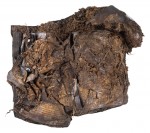 In 2006, Eddie Fogarty was going about his business on a backhoe collecting peat moss from a bog in Faddan More, a townland in northern Tipperary, when he noticed what looked like an open book in the bucket of his digger. He alerted the bog’s owners, Kevin and Patrick Leonard, and together they collected all the fragments they could find. The owners had previous experience discovering archaeological remains in the bog, so they knew that to keep the book from quickly degrading once exposed to oxygen and sunlight they had to cover all the fragments with wet peat. They did so and contacted the National Museum of Ireland to come and get it. If the Leonards hadn’t been so on the ball, the book would have disintegrated within hours.
In 2006, Eddie Fogarty was going about his business on a backhoe collecting peat moss from a bog in Faddan More, a townland in northern Tipperary, when he noticed what looked like an open book in the bucket of his digger. He alerted the bog’s owners, Kevin and Patrick Leonard, and together they collected all the fragments they could find. The owners had previous experience discovering archaeological remains in the bog, so they knew that to keep the book from quickly degrading once exposed to oxygen and sunlight they had to cover all the fragments with wet peat. They did so and contacted the National Museum of Ireland to come and get it. If the Leonards hadn’t been so on the ball, the book would have disintegrated within hours.
 Museum conservators arrived the next morning. The book was open to Psalm 83 (that’s actually Psalm 84 in the English numbering system), and the style of Latin lettering dated the work to the 8th century. This was the first Irish manuscript book to be discovered in over 200 years and the first ever found waterlogged in a bog. It was in poor condition, however, with the vellum clumped together and rolled up at the edges. Its rarity posed a conservation challenge too, because nobody had any experience of how to keep waterlogged inked vellum in a leather cover from degrading.
Museum conservators arrived the next morning. The book was open to Psalm 83 (that’s actually Psalm 84 in the English numbering system), and the style of Latin lettering dated the work to the 8th century. This was the first Irish manuscript book to be discovered in over 200 years and the first ever found waterlogged in a bog. It was in poor condition, however, with the vellum clumped together and rolled up at the edges. Its rarity posed a conservation challenge too, because nobody had any experience of how to keep waterlogged inked vellum in a leather cover from degrading.
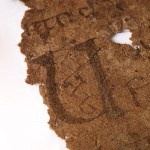 The National Museum staff called on vellum experts from the conservation department of the Trinity College Library in Dublin, where seven of the ten Irish books written before 1000 A.D. that still remain in Ireland are kept, to help them devise a short and long-term conservation plan. For the book’s immediate needs, they ended up using a technique successful in the conservation of bog bodies. They kept the book on a bed of wet peat from the discovery site, then topped it in a layer of silicon mylar with a molded resin cover. The whole bundle was then stored in a refrigerator at just above freezing (4 degrees Celsius or 39.2 degrees Fahrenheit). This method enlists the naturally occurring biocides in the bog water to keep the organic material in the book from growing mold or falling apart.
The National Museum staff called on vellum experts from the conservation department of the Trinity College Library in Dublin, where seven of the ten Irish books written before 1000 A.D. that still remain in Ireland are kept, to help them devise a short and long-term conservation plan. For the book’s immediate needs, they ended up using a technique successful in the conservation of bog bodies. They kept the book on a bed of wet peat from the discovery site, then topped it in a layer of silicon mylar with a molded resin cover. The whole bundle was then stored in a refrigerator at just above freezing (4 degrees Celsius or 39.2 degrees Fahrenheit). This method enlists the naturally occurring biocides in the bog water to keep the organic material in the book from growing mold or falling apart.
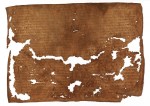 For the next five years, conservators worked to record the contents of the book as much as possible even as they tried to stabilize and restore it. They used photography, High Definition film, drawings, even MRI and multi-spectral imaging to try to document the pages as found. They took samples of 18th century parchment and waterlogged them to experiment with drying techniques like freeze drying and vacuum packing. They also tested various solvents like acetone and ethanol in conjunction with drying techniques to see which combinations would be the most effective at drying the vellum without dissolving the ink, shrinking the pages or ruining their texture.
For the next five years, conservators worked to record the contents of the book as much as possible even as they tried to stabilize and restore it. They used photography, High Definition film, drawings, even MRI and multi-spectral imaging to try to document the pages as found. They took samples of 18th century parchment and waterlogged them to experiment with drying techniques like freeze drying and vacuum packing. They also tested various solvents like acetone and ethanol in conjunction with drying techniques to see which combinations would be the most effective at drying the vellum without dissolving the ink, shrinking the pages or ruining their texture.
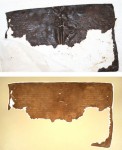 In the end they went with a combination of vacuum drying and ethanol. Always mindful of the need to both record and preserve, they would carefully select substantial pieces as suggested by the position and structure of the book itself, then record them and remove them using hand tools, some of them designed and custom-built specifically for the task at hand. They then separated out the fragments and cleaned them using deionised water and ethanol, recorded them again, and dried them using the vacuum drying-ethanol combo.
In the end they went with a combination of vacuum drying and ethanol. Always mindful of the need to both record and preserve, they would carefully select substantial pieces as suggested by the position and structure of the book itself, then record them and remove them using hand tools, some of them designed and custom-built specifically for the task at hand. They then separated out the fragments and cleaned them using deionised water and ethanol, recorded them again, and dried them using the vacuum drying-ethanol combo.
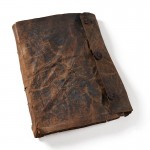 Towards the end of this incredibly painstaking process, conservators found tiny fragments of Egyptian papyrus in the lining of the manuscript’s leather binding. Even though the manuscript is thought to have been penned first and later placed in the Egyptian leather cover, this could be the first concrete evidence of a connection between early Irish Christianity and the Coptic Orthodox Church of Alexandria.
Towards the end of this incredibly painstaking process, conservators found tiny fragments of Egyptian papyrus in the lining of the manuscript’s leather binding. Even though the manuscript is thought to have been penned first and later placed in the Egyptian leather cover, this could be the first concrete evidence of a connection between early Irish Christianity and the Coptic Orthodox Church of Alexandria.
On Tuesday, June 7th, the Faddan More Psalter went on public display at the National Museum of Ireland in Dublin for the first time. Visitors will be able to view the dried and stabilized pages, the leather cover, and a replica that recreates what the psalter looked like when it was new.